Hoping this is ok to add to forum, apologies in advance to administrators if not!
This is to be found on - and struck as interesting information (that we may know but do not necessary always follow (me included) http://care.diabetesjournals.org/content/current and is attributed to: Sheri R. Colberg, Ronald J. Sigal, Bo Fernhall, Judith G. Regensteiner, Bryan J. Blissmer, Richard R. Rubin, Lisa Chasan-Taber, Ann L. Albright, and Barry Braun
http://care.diabetesjournals.org/content/current and is attributed to: Sheri R. Colberg, Ronald J. Sigal, Bo Fernhall, Judith G. Regensteiner, Bryan J. Blissmer, Richard R. Rubin, Lisa Chasan-Taber, Ann L. Albright, and Barry Braun
Exercise and Type 2 Diabetes: The American College of Sports Medicine and the American Diabetes Association: joint position statement
Diabetes Care December 2010 33:e147-e167; doi:10.2337/dc10-9990
This is to be found on - and struck as interesting information (that we may know but do not necessary always follow (me included)
Exercise and Type 2 Diabetes: The American College of Sports Medicine and the American Diabetes Association: joint position statement
Diabetes Care December 2010 33:e147-e167; doi:10.2337/dc10-9990
Exercise and Type 2 Diabetes
The American College of Sports Medicine and the American Diabetes Association: joint position statement
Abstract
Although physical activity (PA) is a key element in the prevention and management of type 2 diabetes, many with this chronic disease do not become or remain regularly active. High-quality studies establishing the importance of exercise and fitness in diabetes were lacking until recently, but it is now well established that participation in regular PA improves blood glucose control and can prevent or delay type 2 diabetes, along with positively affecting lipids, blood pressure, cardiovascular events, mortality, and quality of life. Structured interventions combining PA and modest weight loss have been shown to lower type 2 diabetes risk by up to 58% in high-risk populations. Most benefits of PA on diabetes management are realized through acute and chronic improvements in insulin action, accomplished with both aerobic and resistance training. The benefits of physical training are discussed, along with recommendations for varying activities, PA-associated blood glucose management, diabetes prevention, gestational diabetes mellitus, and safe and effective practices for PA with diabetes-related complications.
Readers may use this article as long as the work is properly cited, the use is educational and not for profit, and the work is not altered. See creativecommons.org/licenses/by-nc-nd/3.0/ for details.

